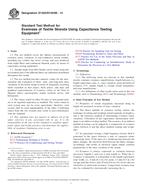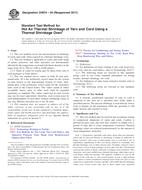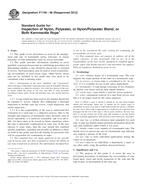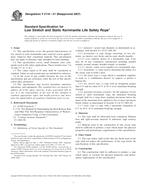Potrebujeme váš súhlas na využitie jednotlivých dát, aby sa vám okrem iného mohli ukazovať informácie týkajúce sa vašich záujmov. Súhlas udelíte kliknutím na tlačidlo „OK“.
ASTM D1578-93(2011)
Standard Test Method for Breaking Strength of Yarn in Skein Form
Automaticky preložený názov:
Štandardná skúšobná metóda pre Pevnosť priadze klbko formulári
NORMA vydaná dňa 1.5.2011
Informácie o norme:
Označenie normy: ASTM D1578-93(2011)
Poznámka: NEPLATNÁ
Dátum vydania normy: 1.5.2011
Kód tovaru: NS-17746
Počet strán: 8
Približná hmotnosť: 24 g (0.05 libier)
Krajina: Americká technická norma
Kategória: Technické normy ASTM
Kategórie - podobné normy:
Anotácia textu normy ASTM D1578-93(2011) :
Keywords:
breaking strength, breaking tenacity, skein, skein break factor, strand, yarn, Breaking strength/tenacity--textile fabrics/fibers, Skeins, Yarn properties, ICS Number Code 59.080.50 (Ropes)
Doplňujúce informácie
| Significance and Use | ||||||||||||||||
|
Test Method D1578 for testing any spun yarn for breaking strength is considered satisfactory for acceptance testing of commercial shipments since the method has been used extensively in the trade. In case of a dispute arising from differences in reported test results when using Test Method D1578 for acceptance testing of commercial shipments, the purchaser and the supplier should conduct comparative tests to determine if there is a statistical bias between their laboratories. Competent statistical assistance is recommended for the investigation of bias. As a minimum, the two parties should take a group of test specimens which are as homogeneous as possible and which are from a lot of material of the type in question. The test specimens should then be randomly assigned in equal numbers to each laboratory for testing. The average results from the two laboratories should be compared using Student's t-test for unpaired data and an acceptable probability level chosen by the two parties before testing is begun. If a bias is found, either its cause must be found and corrected or the purchaser and the supplier must agree to interpret future test results in the light of the known bias. This test method is not suitable for yarns that stretch more than 5 % when the force is increased from 2.5 to 7.5 mN/tex or 0.03 to 0.08 gf/denier, because (a) they require special precautions as to tension in reeling, and (b) users of such yarns are more interested in their elastic behavior at low forces than in their ultimate breaking strength. For Option 1, it is advisable to use a tensile testing machine of the proper capacity to break skeins with 80 turns. If it is necessary to break skeins having only 40 or 20 turns, convert the observed results to an 80-turn basis by multiplying by factors of 2 or 4, respectively. (The available literature does not show that any significant error is introduced by the use of these factors.) The circumference of the skeins used to determine the breaking load is not critical, and as a consequence, close control of the tension at which the skeins are wound is not necessary. If, however, the same skeins are to be used to determine yarn number for any purpose, the skeins must be reeled under controlled tension on a reel meeting the requirements given in Test Method D1907. For some purposes it may be advisable to convert the skein breaking strength observed for yarn of one number to the estimated skein breaking strength of a different yarn number. Factors for making such a conversion for cotton yarns are given in 11.2. No corresponding factors have been developed for yarns spun from other fibers. The results obtained from different options are not fully comparable because the breaking force per wrap increases slightly as the perimeter of the skein is reduced. The skein breaking tenacity observed for 1-m skeins may be as much as 4 % higher, and from 1-yd skeins 5 % higher, than that observed for 1.5-yd skeins. These relationships may vary with the type of yarn or with yarn unevenness and should not be used as conversion factors. With a reasonable number of specimens, this method provides a useful index that combines the effects of unevenness and single strand strength. This method is rarely, if ever, used for filament yarns because their uniformity makes it possible to obtain reliable results economically by the single-strand method. |
||||||||||||||||
| 1. Scope | ||||||||||||||||
|
1.1 This test method covers the determination of the breaking strength of yarn in skein form. The observed breaking strength is expressed in units of force, and equations are provided to convert breaking strength to skein breaking tenacity and to skein break factor. Note 1—For the determination of the breaking strength and elongation of yarn by the single strand method, refer to Test Method D2256. 1.2 This test method is applicable to spun yarns, either single or plied, composed of any fiber or blend of fibers, but is not suitable for yarns which stretch more than 5 % when the tension is increased from 2.5 to 7.5 mN/tex or 0.03 to 0.08 gf/denier. 1.3 This test method provides three options based on the perimeter of the reel, the number of wraps in the skein, and the machine speed or time-to-break. 1.3.1 Option 1—Eighty, forty, or twenty turns on a 1.50-m or 1.5-yd reel, broken at 300 mm/min or 12 in./min. 1.3.2 Option 2—Fifty turns on a 1.00-m or 1-yd reel, broken at 300 mm/min or 12 in./min. 1.3.3 Option 3—Fifty turns on a 1-m reel, broken in 20 s. Note 2—Option 1 is in general use in the United States, Option 2 is used for woolen yarns, and Option 3 has been proposed in the International Standards Organization (ISO) for international use. Note 3—Metric reels are available with 1 and 1.125-m circumferences. Data from the two reels will be about 1 % different (see 5.6). ISO uses a 1-m circumference reel. 1.4 This test method is frequently combined with the determination of linear density carried out on the same skeins. Special precautions for reeling such skeins are noted. 1.5 Where appropriate, this test method states all requirements in SI units. The traditional units are inch-pound and are exact values. 1.6 This standard does not purport to address all of the safety problems, if any, associated with its use. It is the responsibility of the user of this standard to establish appropriate safety and health practices and determine the applicability of regulatory limitations prior to use. |
||||||||||||||||
| 2. Referenced Documents | ||||||||||||||||
|
Podobné normy:
Historická
1.7.2014
Historická
1.1.2011
Historická
1.7.2012
Historická
1.6.2007



 ASTM D1425/D1425M-14..
ASTM D1425/D1425M-14.. ASTM D4974-04(2011)..
ASTM D4974-04(2011).. ASTM F1740-96(2012)..
ASTM F1740-96(2012).. ASTM F2116-01(2007)..
ASTM F2116-01(2007)..
 Cookies
Cookies
